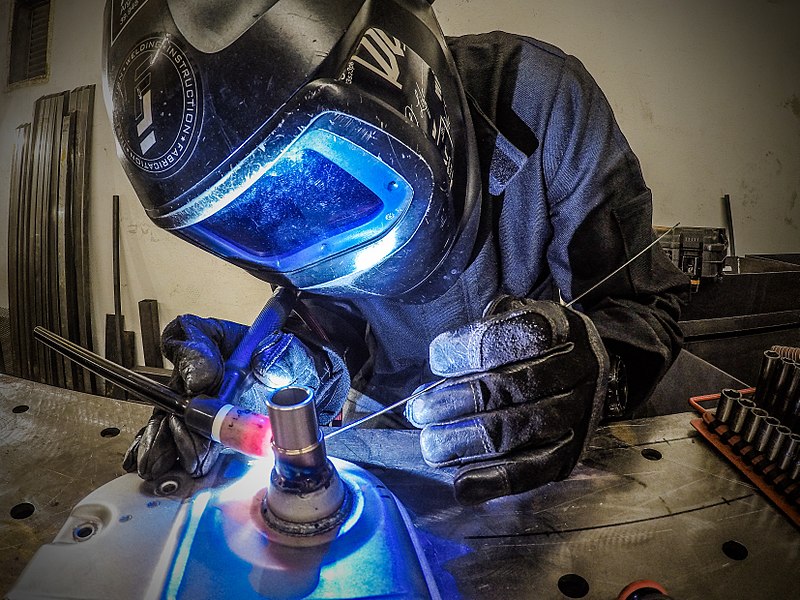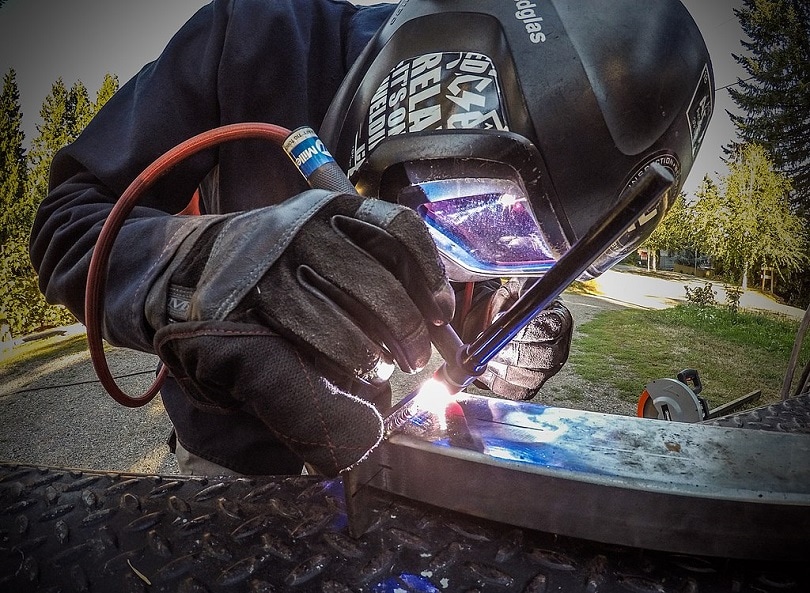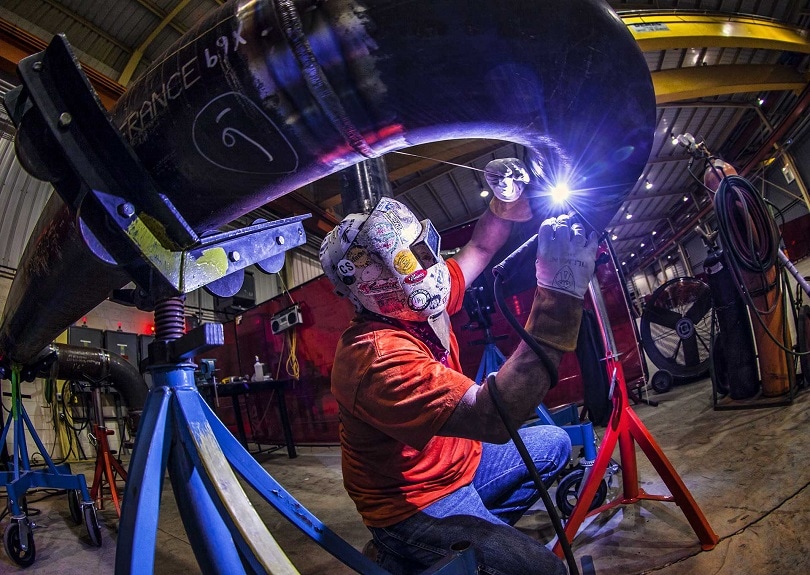What Is TIG (GTAW) Welding? Pros, Cons, & Thorough Guide
Last Updated on

TIG welding is also known to many welders as Gas Tungsten Arc Welding (GTAW). It is a welding process that uses TIG electrodes (which do not dissolve or burn during welding) and an electric arc. TIG welding simply involves the melting of metals together without using any filler metal, as in MIG welding. TIG welding is commonly applied when welding stainless steel, aluminum, and other similar light metals.
TIG is popular because it has the most variables; it is the most expensive weld process and requires the most welding skills. It is also the most versatile weld process, for it can weld most metal types and any thickness. Artists also use TIG for artwork and even in industries that require clean, authentic, and the most pleasant welds.
What Is TIG Welding & Tig Welding Process
During TIG welding, an operator usually holds the torch using one hand, while the other has the filler material. In TIG welding, the torch sends an electric current flowing on the metal. This current heats the metal until it melts slightly and creates a weld puddle. Since TIG weld entirely depends on melting the metal using an electric current, it works best for a thin or narrow metal piece.

In some cases, you will need to use a filler material to help in sealing the weld. When welding, other than using the hands, you can use your foot as a pedal whenever you need to regulate the gas flowing through your welding gun.
The tungsten rod will either be rounded or pointed at the end; this depends on the power source and what metal you are welding. For welding aluminum or magnesium, use AC power and a ball end on your tungsten rod. For stainless steel or steel, use a Direct Current Electrode (DCEN) and a pointed tip on your tungsten rod.
Whether you are joining stainless steel, steel, magnesium, or aluminum, use argon gas with TIG welds. While pushing and pulling works magic for TIG welds, use the push method for TIG welds. TIG requires patience and precision, so take your time if you want the best results. During the welding process, clean the welds, and remember to take all the required welding safety precautions, such as wearing welding safety equipment.
Techniques Used in TIG Welding
Professional welders display better TIG welding techniques because of the experience acquired over the years of welding. Today most metalwork such as piping, nuclear works, and aluminum welding requires at least a root pass, or the first weld should be a TIG welding. Root pass uses the filler material to seal the root space between the weld faces; the process is beneficial when only one side of the weld is visible or accessible. Here are some techniques that professional welders use.
Back-Purging as a Welding Technique
The back-purging technique involves purging the weld zone with argon at a rate of 40 cubic feet per hour. Shielding is essential when using the method. Without proper protection, the weld is highly likely to come out substandard, with defects such as incomplete penetration, root pass suck-back, root pass cracking, and lack of fusion.
- Purging the entire volume of the pipe
- Locally purging the immediate volume around the weld
The flow purge rate should be at 4:1, and the welding torch should make a sound root pass during welding.
What Is TIG Welding Used For?
TIG welding is best suited for applications requiring clean welds and extreme precautions, where strength and appearance matter. If you do not use a filler, TIG will provide a clean weld with nothing visible above the surface, and you will also not see splatters during the process.

Metal thickness is a factor you have to consider because TIG weld cannot produce enough heat to melt thick metals.
TIG does not need a filler material but relies on heat generation from the metal to create a weld pool. It also works perfectly with thin metal sheets and parts that do not conduct electricity well. TIG can weld together dissimilar metals, for instance, carbon steel and aluminum or copper alloys.
In this type of welding, proper fitting of the metal is a must since one cannot correct any fitting error. Remember, it does not use fillers. So, what happens if it does not fit? Do not fret yet; in such a case, do the welding using a pulsed current, it might not fix the problem, but it will accommodate the parts.
TIG welding has several applications, including the construction industry, where each part’s first welds must use TIG welding techniques.
- Nuclear work
- Piping
- Manufacturing visible consumer goods
The automobile industry prefers TIG welding because it is clean and leaves no visible signs of welding activity. Other application areas include aerospace components, pipes, shipbuilding.
- Strength
- Corrosion resistance
- Weld to seal
- Visually appealing
- Can weld almost all metal, including Al, Mg, Cu alloys, steel, and stainless steel
- Allows better control of the weld since the welder uses both hands
- Welds formed are corrosion resistant
- Welds thin metal sheets
- Suitable for a project with detailed design
- Allows welder to control heat and amperage
- Have remote control switches
- Produce clean welds
- Forms ductile welds
- It can weld metals with different thickness
- Welding is possible in any position: vertical and horizontal
- TIG welding machines can do traditional stick welding
- Used in joining curves
- Seals the weld well, making the bond super strong
- It is a clean process because of the fewer emissions, sparks, smoke, and splatters
- Produces high-quality welds with precision
- Offers better viability during the welding process
- It is a complex process
- It is a hard-to-train and hard-to-master process because it has a steeper learning curve
- It is time-consuming since the process is slow
- It is not portable; this makes it only suitable for immobile workshops
- Controlling the flow of gas is a gruesome task, especially for beginners
Component of Gas Tungsten Arc Welding (GTAW)
For the TIG welding process to be complete, a TIG welder and the four main components that a welder must-have.
- Source of power
- Shielding gas
- Electrode
- Welding Torch
Source of Power
TIG welding requires a constant source of power, supplied through a transformer-rectifier. The power source should be strong and have a consistent flow.
Electrode
Use either tungsten alloy or pure tungsten as your TIG welding electrode. These are the preferred electrodes because of their high melting point ranging from 3410 degrees to 6170 degrees Fahrenheit.
During the welding process, the electrode acts as an electric terminal responsible for generating the heat required to melt the metal. TIG welding electrodes come in different sizes, colors, and lengths. GTAW electrodes are color-coded to help you distinguish them.
| GTAW Electrode | Color Code |
| Rare earth | Grey |
| Pure tungsten | Green |
| Lanthanated | Gold |
| Ceriated | Orange |
| Thoriated | Red |
| Zirconiated | Brown |
Welding Torch
The TIG welding torch conveys the shielding gas through a nozzle and also holds the electrode. It also has a clumping device known as a collet that holds the electrode in position. Collets are mostly made from copper, while nozzles are from ceramic materials. You can either purchase the air-cooled or water-cooled TIG torches.
Shielding Gas
Shielding gas is conveyed through the nozzle to prevent the molten pool from atmospheric contamination. Inert gases such as helium, argon, or a combination of both. Argon is cheaper compared to helium, and it also provides a quieter arc that is smooth.
Argon provides a reduced penetration hence used to weld thinner metals. At the same time, helium has a high heat penetration, which is useful for material high heat conductivity and thick metals such as copper and aluminum.
Frequently Asked Questions
What Is the Purpose of a Shielding Gas in TIG Welding?
The shielding gas’s primary role is to prevent the molten pool from interacting with oxygen, hydrogen, and nitrogen from the atmosphere. If the molten pool reacts with these gases, it can jeopardize the weld by creating complications such as excessive spattering and porosity (holes in a weld).
To avoid such issues, use an inert shielding gas such as argon, helium, or helium mix.
What Are the Main Equipment Used in TIG Welding?
TIG welding is a complex welding process with a steep learning curve.
- Welding torch
- Tungsten electrode (non-consumable)
- Source of power
- Shielding gas (argon or helium)
Parting Shot
In GTAW welding application, you have to choose the best electrode and shielding gas with the correct flow rate and consumables to help you achieve the best weld. You also need to be patient enough to learn all the techniques and gain the much-needed experience.
We hope you have enjoyed our guide into what TIG welding is and now have a better understanding of its process.
Featured image credit: Prowelder87, Commons Wikimedia
